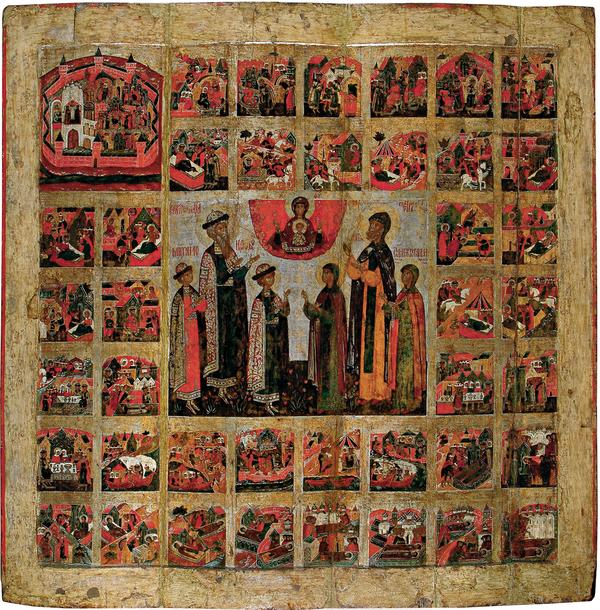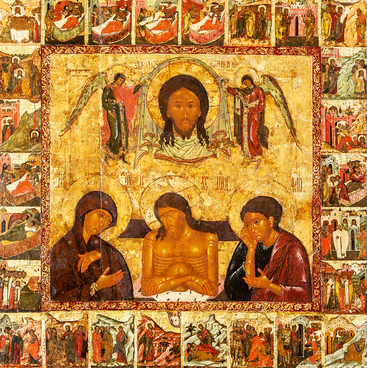The icon with the six miracle-workers of Murom in the centrepiece was created by an unknown icon-painter in 1669. The border scenes around the centrepiece depict scenes that are not connected with all Murom saints but only those from the hagiography of saint faithful spouses Prince Pyotr and Princess Fevronia.
The icon was ordered by an inhabitant of Murom’s trading quarter by the name of “Sidor Matveev, the son of Lopatin.” It was intended for St.George’s Church. This church built in 1651 was also funded by Sidor Lopatin. That is where it was housed in the annex at the entrance called an antechurch. On the reverse side of the icon there is an inscription: ‘In the year 7178, October…, on… (day) the icons Resurrection of Christ, Miracle-Workers of Murom and Christian Martyrs George and Nikita, Boris and Gleb, the passion-bearers, were painted as promised by Sidor Matveev, the son of Lopatin’.
The icon’s centerpiece depicts all miracle-workers of Murom: princes Konstantin, Mikhail and Fyodor, Pyotr, Fevronia and the righteous Juliana of Lazarevo. In the part of the icon symbolizing the heavens Our Lady of the Incarnation is depicted. All saints are depicted in prayers to the Virgin Mary. Fine art experts believe that such an image of Our Lady appeared here under the influence of iconography of the tomb pall of Pyotr and Fevronia dated 1593. This pall was one of the city’s objects of worship.
The icon is the oldest of all the surviving images of Murom’s miracle-workers put together. Prince Konstantin who converted the people of Murom, the heathens, into Christianity and Prince Pyotr were depicted twice as taller as the rest of the characters. Fine art experts assume that such a difference in height underlined the hierarchical precedence of the princes.
The righteous Juliana is painted next to the St.Fevronia and is similar to her in height and even in clothing: modest mundane clothes of Juliana are hardly different from the monastic dress of Fevronia. This similarity, as well as prayer beads in Juliana’s hands demonstrate her piousness and ceaseless deeds of devotion.
As a model the icon-painter took the well-known icon of Pyotr and Fevronia of the late 16th – early 17th century from the Cathedral of the Nativity of the Blessed Virgin Mary. On this icon instead of all Murom’s miracle-workers a panorama of Murom was depicted.
The icon’s centerpiece depicts all miracle-workers of Murom: princes Konstantin, Mikhail and Fyodor, Pyotr, Fevronia and the righteous Juliana of Lazarevo. In the part of the icon symbolizing the heavens Our Lady of the Incarnation is depicted. All saints are depicted in prayers to the Virgin Mary. Fine art experts believe that such an image of Our Lady appeared here under the influence of iconography of the tomb pall of Pyotr and Fevronia dated 1593. This pall was one of the city’s objects of worship.
The icon is the oldest of all the surviving images of Murom’s miracle-workers put together. Prince Konstantin who converted the people of Murom, the heathens, into Christianity and Prince Pyotr were depicted twice as taller as the rest of the characters. Fine art experts assume that such a difference in height underlined the hierarchical precedence of the princes.
The righteous Juliana is painted next to the St.Fevronia and is similar to her in height and even in clothing: modest mundane clothes of Juliana are hardly different from the monastic dress of Fevronia. This similarity, as well as prayer beads in Juliana’s hands demonstrate her piousness and ceaseless deeds of devotion.
As a model the icon-painter took the well-known icon of Pyotr and Fevronia of the late 16th – early 17th century from the Cathedral of the Nativity of the Blessed Virgin Mary. On this icon instead of all Murom’s miracle-workers a panorama of Murom was depicted.




